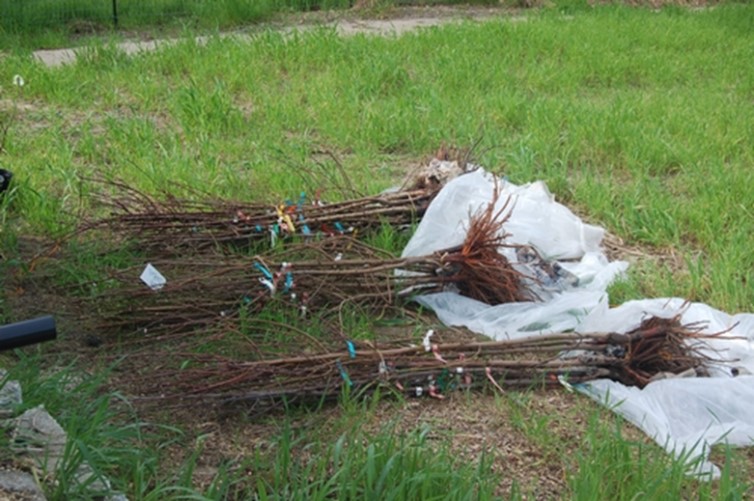
Trees for Rural Roads Program - now accepting 2025 applications!
The Municipality of Clarington is pleased to once again offer the Trees for Rural Roads program for 2025! Applications are now being accepted until March 31, 2025.
Each spring, trees are offered free of charge to rural residents to be planted by the landowner on their private property adjacent to municipal roadways. Participants have their choice of selection of native tree species and must adhere to a set of program guidelines, which are outlined below.
Did you know? Since the start of the program in 2012, more than 8,800 native trees and shrubs have been distributed and planted along our rural roadsides. This has helped to maintain and restore Clarington’s rural character, provide ecological value, and contribute to local efforts to take action on climate change. Learn more about trees in Clarington.
All applicants will be notified of the results of their application. Successful applicants will be contacted in early April with next steps, including tree pickup day which will be scheduled for a Saturday in April.
The Trees for Rural Roads program is made possible through the generous support of our many program partners – Central Lake Ontario Conservation Authority, Ganaraska Region Conservation Authority, and Maple Leaves Forever.
Please carefully review the following program guidelines and submit your complete application before March 31, 2025, along with the required supporting information, directly to the applicable Conservation Authority – Central Lake Ontario or Ganaraska Region.
Supporting documents
- 2025 Trees for Rural Roads Program Guidelines and Application Form (PDF)
- Conservation Authority Area Map (PDF)
- Information Sheet: Preparing to Submit Your Application (PDF)
| Background |
|
The earliest large-scale, systematic planting efforts date back 150 years to when the Ontario Legislature passed an act in 1871 encouraging the planting of trees on highways. Municipalities were to pay landowners up to $0.25 per tree for trees planted along the roads. The province was to cost-share with the municipalities, but a quarter century later, only ten percent of the money had been spent, and the act was repealed. Although this would suggest the program failed, trees from this era (or soon after) line many of our roads today. The majority of trees farmers transplanted from their woodlots were maples. This gave rise to an important element in the rural landscape-lines of stately maples alongside roads. The legacy of tree-lined roads is embedded in many people's memories and part of the rural aesthetic. These century-old (and older) trees are succumbing to old age, exposure to wind, insects, and disease. The program was developed in 2012 to help replace and plant trees along our rural roadways. |
| Benefits |
|
The Trees for Rural Roads program benefits the local environment, community and economy. It provides increased tree canopy cover and wildlife habitat, as well as climate change mitigation, local history preservation and community engagement. |
| Location of roadside planting |
|
Trees must be planted just inside the property line on private property, adjacent to the road right of way. Offset must be provided from power lines and other overhead or underground obstructions.
Photo above: White Spruce planted in 2012 as part of Trees for Rural Roads |
| Program guidelines |
|
The Trees for Rural Roads program is available to all rural residents. The trees provided for free by the program, are to be planted along roadways by the private property owners on their land (being their contribution). The Trees for Rural Roads program is not designed to plant along laneways, within private yards or for hedgerow replacement. If property owners desire more trees for laneway planting and other locations, the Conservation Authorities may be able to assist with other programs they operate. Trees will not be provided to plant along Provincial roadways, private roads, unopened/unmaintained roads or urban areas (Courtice, Bowmanville, Newcastle, and Orono). |
| Types of trees |
|
The program distributes bare-root and potted deciduous stock 1 to 1.5 metres in height and small potted coniferous trees (half-metre height). This size is easier to transport and plant, and the growth will catch up to caliper stock over time. Native trees include sugar, red, and silver maples; red and white oak; white pine; white spruce; and white birch. Tree guards for the deciduous trees and mulch mats for all trees are provided for free.
Photo above: Bundles of bare-root trees at 2015 Trees for Rural Roads Pick-up |
| How many trees can I get? |
| The program allows the number of trees needed to plant one row along the roadway. The spacing requirement is one deciduous tree for every 40 feet of road frontage, and one evergreen tree for every 20 feet of road frontage. This will allow for a full tree canopy to develop. A maximum of 30 trees per year are allowed. Replacement trees as a result of mortality are also allowed. We will provide planting instructions to all program participants. |
| When do I get my trees? |
|
You will receive tree pickup information once your application is accepted. Trees pickup is typically coordinated at the Orono Works Yard at the end of April.
Photo above: Potted, coniferous and deciduous trees ready for pick up at the Orono Depot in 2016 |
| Other programs |
Questions?
Email Sylvia Jennings, Planner I, or 905-623-3379 ext. 2335.
Contact Us







